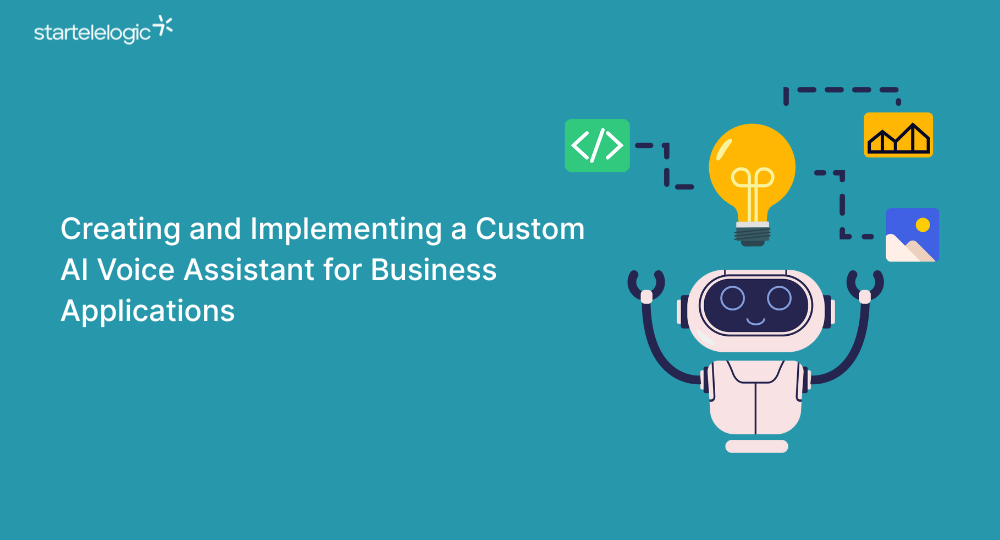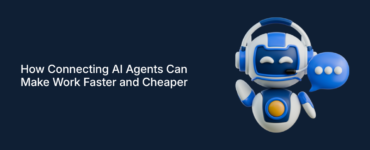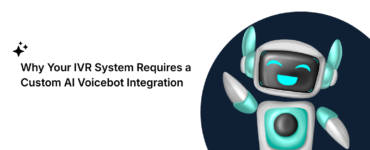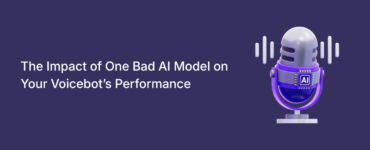The use of AI voice assistant has skyrocketed in both personal and professional settings. Statista reports that more than 8.4 billion digital voice assistants are projected to be in use worldwide in 2024—surpassing the global population. What began with smart speakers such as Alexa and Siri has evolved into the business world, where organizations now adopt custom AI-powered voice solutions to boost efficiency, improve customer experience, and increase overall productivity. Beyond automating routine tasks, these assistants are now capable of handling complex queries, integrating with enterprise systems, and providing real-time support across multiple channels. Businesses are also leveraging them to gather valuable insights from customer interactions, streamline internal communication, and reduce operational costs. This growing reliance highlights how voice-driven technology is becoming a critical asset for achieving digital transformation and gaining a competitive edge.
Why Businesses Need Voice-Driven Solutions
Generic voice assistants are powerful, but they are designed for general use. Businesses, however, require tailored solutions—ones that understand industry-specific terminology, integrate smoothly with internal systems, and deliver secure, reliable interactions that meet professional standards.
- Customer Support:
A custom AI voice assistant can serve as the first line of interaction for customers by handling frequently asked questions, guiding users through order placements, and resolving basic technical issues. This not only reduces the workload of human agents but also ensures faster response times, 24/7 availability, and a consistent customer experience. As a result, businesses can lower operational costs while maintaining high levels of customer satisfaction. - Internal Operations:
Within organizations, employees benefit from hands-free assistance for everyday tasks such as scheduling meetings, retrieving company data, or generating performance reports. Voice integration with tools like CRM systems, calendars, and databases can significantly cut down manual effort, allowing staff to focus on higher-value tasks. Additionally, employees working in field operations or on-the-go roles can perform complex actions without needing to stop and type, improving efficiency and safety. - Sales and Marketing:
Conversational AI can play a crucial role in personalizing customer journeys. Voice assistants can recommend products based on user preferences, past purchases, or browsing history, leading to improved upselling and cross-selling opportunities. They can also assist sales teams by qualifying leads, capturing customer insights in real time, and nurturing prospects with engaging, interactive dialogues. This creates a smoother funnel for conversion while giving marketing teams actionable data for campaigns.
Key Steps in Creating a Custom AI Voice Assistant
Building a business-ready AI voice assistant is not just about coding—it’s about aligning technology with strategy. Here are the main steps:
- Identify the Use Case
Define what problems you want the assistant to solve—customer service automation, employee productivity, or personalized client interactions. - Choose the Right Technology Stack
Tools like Google Dialogflow, Amazon Lex, or open-source frameworks can be used, depending on your integration needs and budget. - Design Natural Language Understanding (NLU)
Train the assistant to understand industry jargon, customer queries, and conversational patterns to ensure natural interactions. - Integrate with Business Systems
Connect the assistant with CRM, ERP, or customer databases so it can provide real-time, accurate responses. - Ensure Security and Compliance
Especially in industries like healthcare or finance, data privacy and compliance (HIPAA, GDPR, etc.) must be a top priority. - Test and Optimize
Continuous feedback and training help refine the assistant’s responses, ensuring better accuracy and user satisfaction over time.
Benefits of Implementing Voice Technology
- 24/7 Availability
Customers can connect with your business at any time of day, even outside regular working hours. A voice assistant ensures uninterrupted support, answering queries, processing requests, and maintaining consistent service without downtime. This round-the-clock availability strengthens trust and reliability. - Lower Costs
Automating repetitive and routine tasks reduces the need for large support teams, significantly cutting staffing and training expenses. Businesses can redirect human resources toward more complex, value-driven activities while the AI handles standard interactions efficiently. - Better User Experience
With quick responses, personalized recommendations, and natural conversations, customers feel understood and valued. The smoother experience leads to greater satisfaction, stronger engagement, and improved loyalty over time, enhancing long-term relationships. - Scalability
During peak hours or seasonal demand, the voice assistant can handle thousands of interactions simultaneously without compromising quality. This flexibility allows businesses to scale operations instantly, without the delays and costs of hiring additional staff. - Competitive Edge
Companies that adopt AI voice assistants early can differentiate themselves in crowded markets. Offering faster service, smarter interactions, and innovative engagement creates a brand image of being forward-thinking, giving businesses an advantage over slower-moving competitors.
Common Challenges and How to Overcome Them
While AI voice assistants bring major advantages, businesses often encounter obstacles during deployment. Addressing these challenges effectively ensures smooth adoption and long-term success.
- Understanding Complex Queries
One of the biggest hurdles is ensuring the AI can correctly interpret natural, industry-specific language. Customers may use slang, abbreviations, or complex sentence structures that confuse the system.
Solution: Invest in ongoing Natural Language Understanding (NLU) training, using real customer interactions to refine accuracy. Incorporating machine learning models that adapt over time helps the assistant improve continuously. - Integration Issues
Many businesses already rely on multiple tools—CRMs, ERP systems, databases, and communication platforms. Without proper integration, the AI assistant may operate in isolation and fail to provide real value.
Solution: Use APIs, middleware, and cloud-based integration frameworks to seamlessly connect the AI with existing business systems. This ensures smooth data flow, unified workflows, and a consistent user experience. - User Resistance
Employees and customers may hesitate to trust or use an AI-driven solution, fearing it will replace human interaction or deliver impersonal service. Such resistance can slow adoption.
Solution: Implement a hybrid model where the AI handles routine queries while humans step in for complex or sensitive cases. Gradually, as users experience the efficiency and reliability of the system, confidence in the AI grows. - Data Privacy Concerns
Since voice assistants often process sensitive information—like customer details, orders, or financial records—privacy and compliance become critical. Any data mishandling can damage trust and create legal risks.
Solution: Prioritize strict compliance with regulations (e.g., GDPR, HIPAA, or local data laws) and maintain full transparency about how data is stored and used. Incorporating strong encryption, access controls, and anonymization practices further safeguards user trust.
The Future of AI in Voice Technology
The future of AI voice assistants goes far beyond answering basic questions. As voice recognition and AI continue to evolve, these assistants will grow into true business partners—anticipating customer needs, offering proactive solutions, and integrating effortlessly into daily operations.
For businesses, this isn’t just about keeping up with technology—it’s about staying ahead of the curve. Companies that start building their own custom AI voice assistants today will streamline internal processes, deliver richer customer experiences, and position themselves as leaders in a rapidly changing market. In the long run, the question won’t be “Should we use AI voice assistants?” but rather “How could we ever manage without them?”
Frequently Asked Questions (FAQs) About AI Voice Assistants
1. What is an AI voice assistant?
An AI voice assistant is a software application powered by artificial intelligence that uses voice recognition and natural language processing to interact with users. It can answer questions, perform tasks, and automate processes using voice commands.
2. How can businesses benefit from AI voice assistants?
Businesses can use AI voice assistants to improve customer service, automate repetitive tasks, enhance employee productivity, and scale operations without increasing costs. They also provide 24/7 support, which boosts customer satisfaction.
3. What is the difference between a generic and a custom AI voice assistant?
Generic voice assistants like Alexa or Siri are designed for everyday personal use. A custom AI voice assistant is tailored to a company’s needs, trained with industry-specific terminology, and integrated with business systems such as CRM or ERP.
4. Can AI voice assistants replace human employees?
No, AI voice assistants are not designed to replace humans. Instead, they complement staff by handling routine queries and tasks, allowing employees to focus on more complex, value-driven work.
5. Are AI voice assistants secure for business use?
Yes, with the right security measures. Businesses must implement encryption, authentication, and compliance with regulations like GDPR or HIPAA to ensure data privacy and secure interactions with AI voice assistants.
6. Which industries use AI voice assistants the most?
Industries like healthcare, finance, e-commerce, and customer service widely use AI voice assistants. They help patients book appointments, allow customers to check account balances, and even assist shoppers with product recommendations.
7. How do AI voice assistants understand complex queries?
AI voice assistants use Natural Language Understanding (NLU) and machine learning to process human language. With continuous training and real customer interaction data, they improve accuracy over time.
8. What technology is used to build a custom AI voice assistant?
Popular tools include Google Dialogflow, Amazon Lex, Microsoft Azure Cognitive Services, and open-source platforms like Rasa. The choice depends on integration needs, scalability, and budget.
9. Can an AI voice assistant be integrated with existing business systems?
Yes. Businesses can integrate voice assistants with CRM systems (Salesforce, HubSpot), ERP platforms, databases, and communication tools, ensuring seamless workflows and real-time access to data.
10. What is the future of AI voice assistants in business?
The future of AI voice assistants lies in becoming proactive business partners. They will predict customer needs, provide advanced personalization, and fully integrate into digital ecosystems—making them essential for digital transformation.




